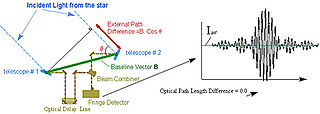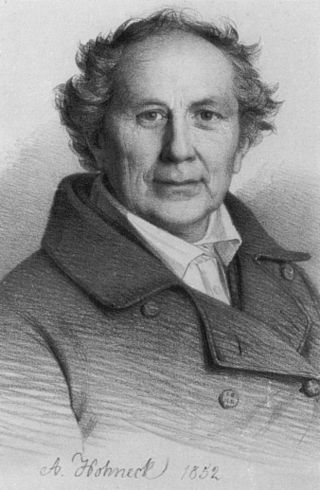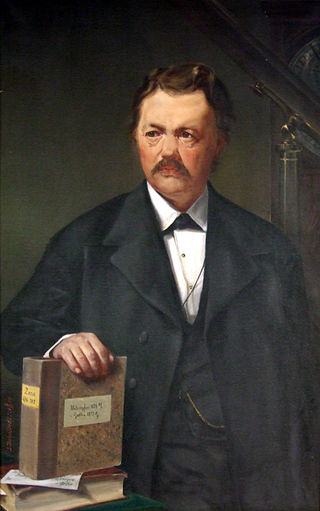
Astrometry is a branch of astronomy that involves precise measurements of the positions and movements of stars and other celestial bodies. It provides the kinematics and physical origin of the Solar System and this galaxy, the Milky Way.

A star catalogue is an astronomical catalogue that lists stars. In astronomy, many stars are referred to simply by catalogue numbers. There are a great many different star catalogues which have been produced for different purposes over the years, and this article covers only some of the more frequently quoted ones. Star catalogues were compiled by many different ancient people, including the Babylonians, Greeks, Chinese, Persians, and Arabs. They were sometimes accompanied by a star chart for illustration. Most modern catalogues are available in electronic format and can be freely downloaded from space agencies' data centres. The largest is being compiled from the spacecraft Gaia and thus far has over a billion stars.
Timeline of astronomical maps, catalogs and surveys

Friedrich Wilhelm August Argelander was a German astronomer. He is known for his determinations of stellar brightnesses, positions, and distances.
The Guide Star Catalog (GSC), also known as the Hubble Space Telescope, Guide Catalog (HSTGC), is a star catalog compiled to support the Hubble Space Telescope with targeting off-axis stars. GSC-I contained approximately 20,000,000 stars with apparent magnitudes of 6 to 15. GSC-II contains 945,592,683 stars out to magnitude 21. As far as possible, binary stars and non-stellar objects have been excluded or flagged as not meeting the requirements of Fine Guidance Sensors. This is the first full sky star catalog created specifically for navigation in outer space.

Eduard Schönfeld was a German astronomer.

Hoher ListObservatorium is an Observatory located on the Hoher List mountain about 60 km south-west of the city of Bonn, close to the town of Daun in the Eifel region (Rhineland-Palatinate)
The Catalogue of Fundamental Stars is a series of six astrometric catalogues of high precision positional data for a small selection of stars to define a celestial reference frame, which is a standard coordinate system for measuring positions of stars.
The Tycho-2 Catalogue is an astronomical catalogue of more than 2.5 million of the brightest stars.
The Astronomische Gesellschaft Katalog (AGK) is an astrometric star catalogue. Compilation for the first version, AGK1, was started in 1861 by Friedrich Argelander and published between 1890 and 1954, listing 200 000 stars down to ninth magnitude.

Celestial cartography, uranography, astrography or star cartography is the aspect of astronomy and branch of cartography concerned with mapping stars, galaxies, and other astronomical objects on the celestial sphere. Measuring the position and light of charted objects requires a variety of instruments and techniques. These techniques have developed from angle measurements with quadrants and the unaided eye, through sextants combined with lenses for light magnification, up to current methods which include computer-automated space telescopes. Uranographers have historically produced planetary position tables, star tables, and star maps for use by both amateur and professional astronomers. More recently, computerized star maps have been compiled, and automated positioning of telescopes uses databases of stars and of other astronomical objects.
HD 155358 is a low metallicity yellow dwarf star approximately 43 pc away in the constellation Hercules. This star is known to be orbited by two extrasolar planets.

The Sharpless catalog is a list of 313 H II regions intended to be comprehensive north of declination −27°. The first edition was published in 1953 with 142 objects (Sh1), and the second and final version was published by US astronomer Stewart Sharpless in 1959 with 312 objects. Sharpless also includes some planetary nebulae and supernova remnants, in addition to H II regions.
In astronomy, an equinox is either of two places on the celestial sphere at which the ecliptic intersects the celestial equator. Although there are two such intersections, the equinox associated with the Sun's ascending node is used as the conventional origin of celestial coordinate systems and referred to simply as "the equinox". In contrast to the common usage of spring/vernal and autumnal equinoxes, the celestial coordinate system equinox is a direction in space rather than a moment in time.

Karl Nikolaus Adalbert Krueger was a German astronomer. Born in Marienburg, Prussia, he was editor of Astronomische Nachrichten from 1881 until his death.

Star position is the apparent angular position of any given star in the sky, which seems fixed onto an arbitrary sphere centered on Earth. The location is defined by a pair of angular coordinates relative to the celestial equator: right ascension and declination. This pair based the equatorial coordinate system.
The PPM Star Catalogue is the successor of the SAO Catalogue. It contains precise positions and proper motions of 378,910 stars on the whole sky in the J2000/FK5 coordinate system. It is designed to represent as closely as possible the IAU (1976) coordinate system on the sky, as defined by the FK5 star catalogue. Thus, the PPM is an extension of the FK5 system to higher star densities and fainter magnitudes.
HD 156668 is a star in the northern constellation of Hercules constellation. With an apparent visual magnitude of 8.4 it is too faint to be viewed with the naked eye, but it can be seen with even a small telescope. The distance to this object has been determined directly using the parallax technique, yielding a value of about 80 light-years.

The parallactic instrument of Kapteyn is a measuring instrument created by the Dutch astronomer Jacobus Kapteyn around 1886. Using this instrument, Kapteyn analyzed over 1,700 glass plate photos of stars seen from the southern hemisphere. This research contributed to the Cape Photographic Durchmusterung, a star catalogue containing 454,875 entries. Together with the measurements of stars seen from the northern hemisphere the measurements of Kapteyn formed a complete star catalogue with a scope and accuracy that was impressive for its time.








